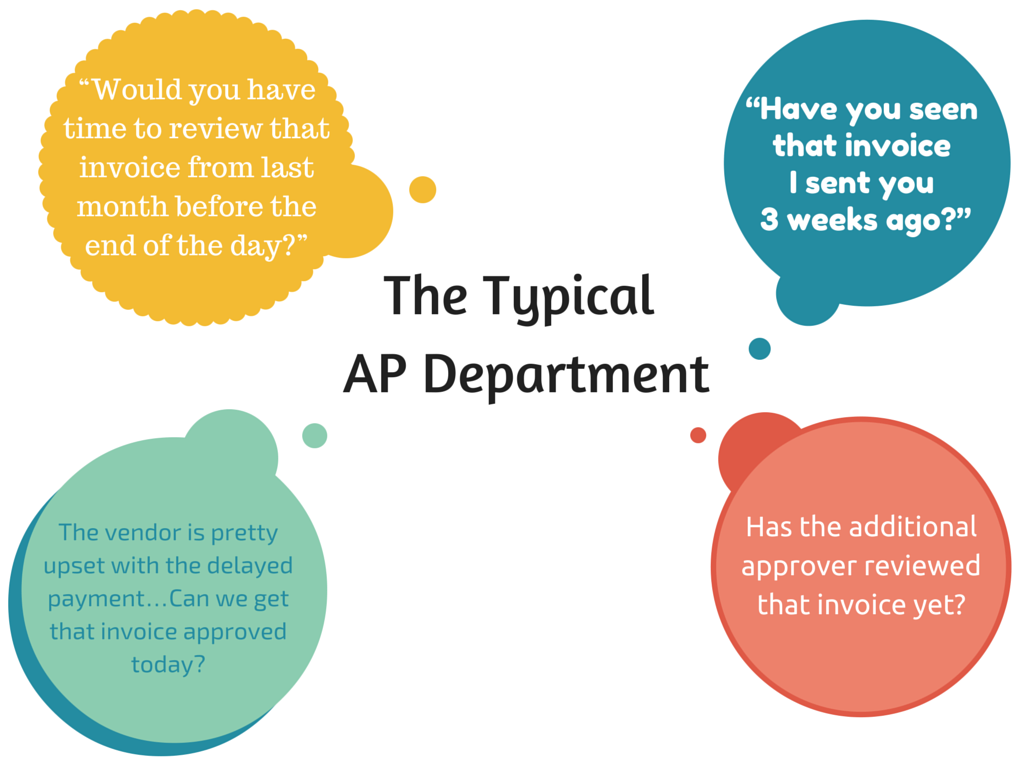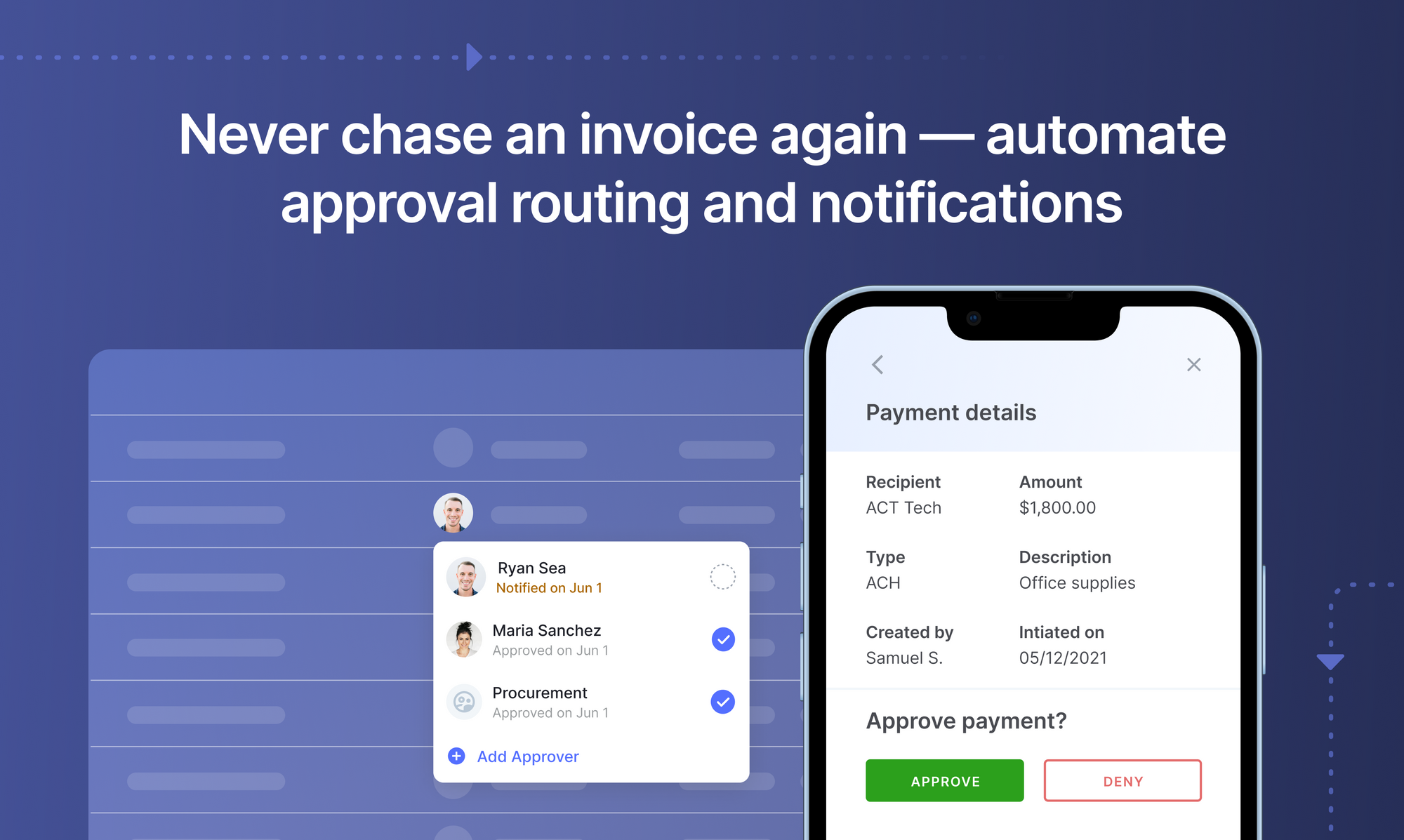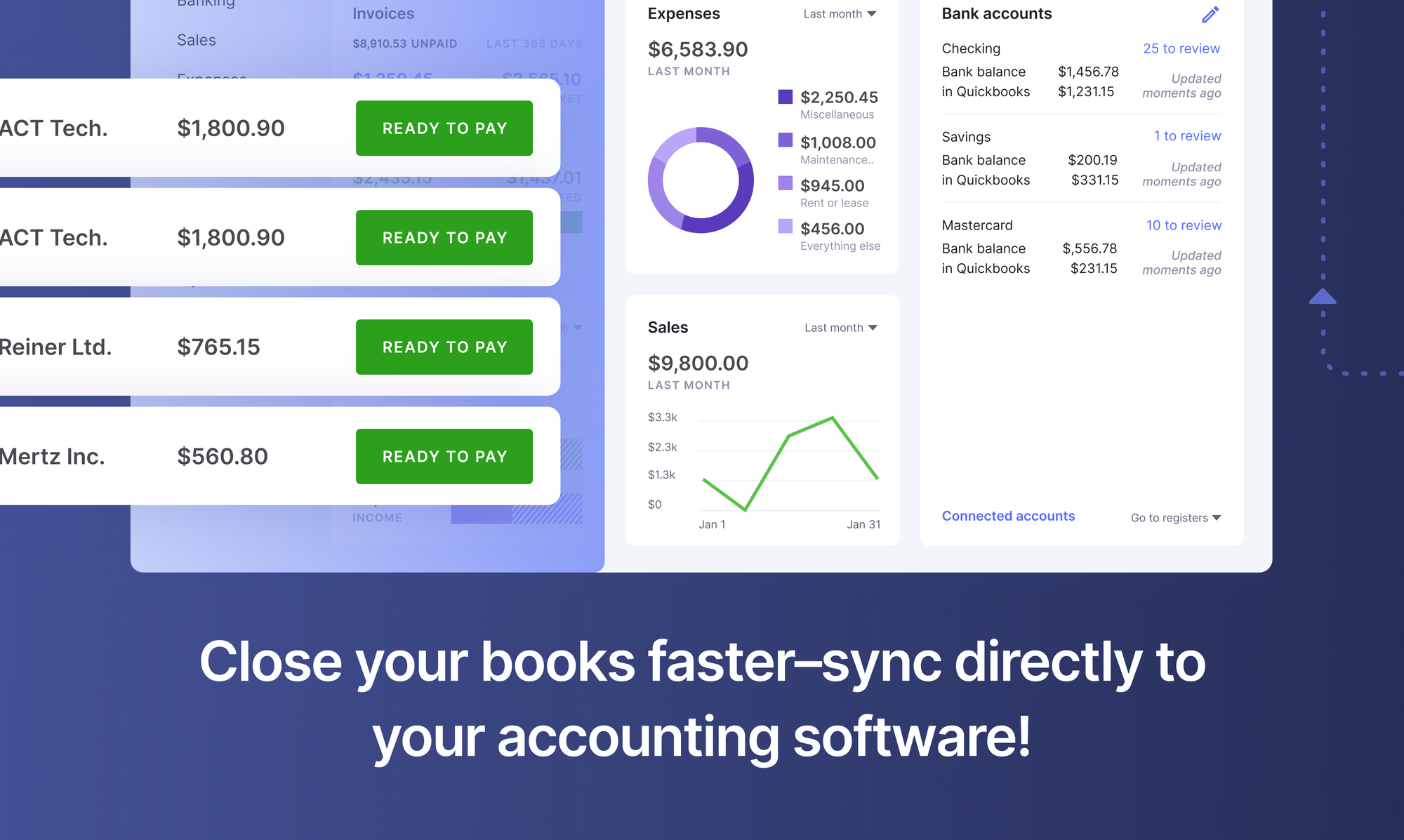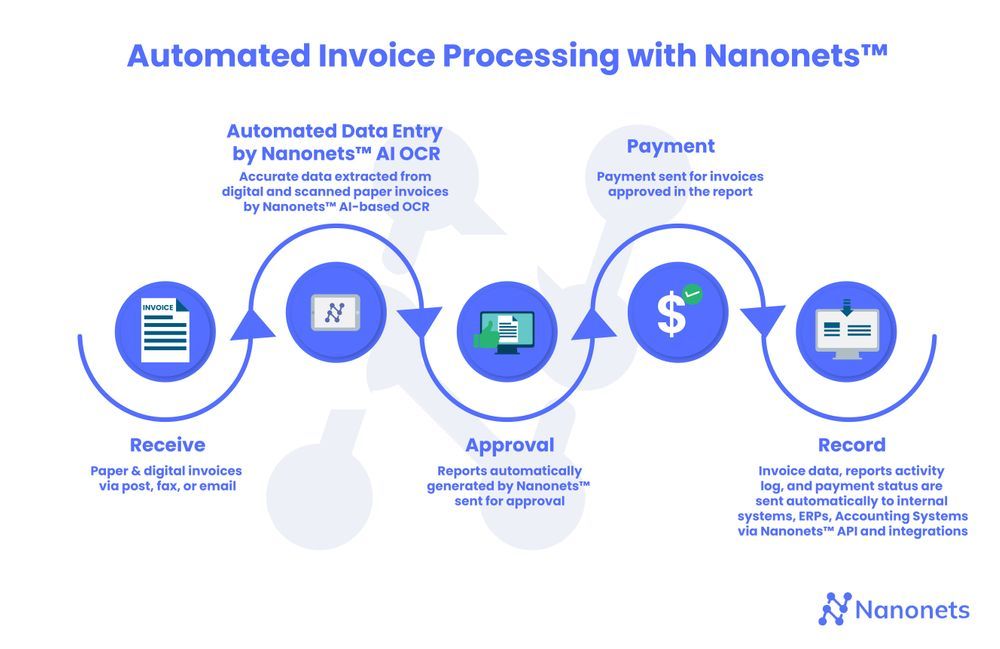Invoice approval workflow guide
Invoice approval is fundamental in any organization's accounts payable (AP) department. It's a systematic approach that ensures all vendor invoices are reviewed, verified, and approved before payment is disbursed. With the advent of new technology, businesses are increasingly adopting invoice automation or invoice approval software to streamline this process, reduce inefficiencies, and save valuable resources.
The Accounts Payable (AP) departments of most companies have internal rules for invoice management that include approvals. What are invoice approvals? What is a manual invoice approval workflow? Why automate the AP invoice approval workflow?
Read on to understand the invoice approval process.

Looking to automate your manual AP Processes? Book a 30-min live demo to see how Nanonets can help your team implement end-to-end AP automation.
The operation of the AP department in a business, be it product- or service-oriented, is critical for the productivity of the company and for the maintenance of good supplier relationships. An efficient AP department that provides financial, administrative, and clerical support to the purchase process of a company, must have an organized system that seamlessly integrates the various functions of the procure-to-pay process that spans purchase order management, vendor communication, invoice management, product tracking, and payment.
Invoice management commences when an invoice is received by a company and ends with the payment of the invoice, is one of the most important functions of the AP department of the company. As simplistic as it may sound, invoice management is not, or should not be, a two-step process of ‘receive invoice, pay invoice.’ This is especially true for companies that make a lot of purchases and end up with a large number of invoices. A good invoice management protocol must necessarily involve verification of the legitimacy of all invoices and multi-level approvals before they can be processed for payment.

The invoice approval workflow
The invoice approval workflow is a cascade of steps in the procure-to-pay process that are taken to ensure that an invoice received by the company is legitimate and matches the order made. The invoice approval involves multiple levels of checking by personnel responsible for a purchase order and/or a vendor. Each company can have its own unique approval workflow
A typical invoice approval workflow comprises the following steps:
An invoice arrives at a company. The invoice may be in the form of a hard copy, or a PDF attachment or a more advanced form of a digital invoice, that must be filed in the appropriate section for processing.
- Invoice validation: Once filed, the invoice is linked to any other documents related to that particular transaction such as purchase requisition, purchase order, the quotation from the vendor, other communication from the vendor, etc. This is commonly referred to as “three-way matching”, the three documents to be matched being Purchase Order, Invoice, and Delivery receipt, but matching may include other documents as well. Other factors to consider for validation include:
- Are the payment terms matched?
- Are any promised discounts included?
- Has the invoice been coded to the appropriate expense accounts?
- Are there performance issues post receipt that warrant withholding payment?
- Invoice exceptions: An exception is raised when an invoice has incomplete or incorrect information. The invoice is rerouted to appropriate employees to track and correct the error. This is followed by invoice re-issues, re-verifications, and matching in case of error correction, or fraud investigation in case of unresolved exceptions.
- Approval: Once verified, the invoice is routed to personnel at various levels depending upon the policies of the company. The number and nature of approvals varies between companies, departments, product type and invoice amount. As an example, the purchasing department may have to approve an invoice to confirm the accuracy of the vendor’s billing before payment can be processed. Some companies require invoice amounts higher than a threshold to require additional approvals from a manager or CFO.
- Payment: The invoice enters the payment queue after all approvals have been obtained.
Many small and mid-sized companies continue to have manual invoice approval workflows. These may involve actions as rudimentary as having a word processing document à la an SOP, with delineated steps and distribution of the document to the various participants of the workflow to be used as a guide. This is, as can be imagined, a disorganized process that requires the participants to keep referring to the document following the steps, which may lead to errors.
In many small companies, there is not even such an SOP and there is just a general procedure that is passed on word-of-mouth to the various participants, which is a recipe for disaster when the company undergoes any form of alteration, be it scaling up or changing its employee base.
Set up touchless AP workflows and streamline the Accounts Payable process in seconds. Book a 30-min live demo now.

Problems with the manual invoice approval workflow
Some of the specific challenges of manual invoice approval workflow are:
- Errors: Human errors due to overwork or simply oversight can lead to double payments, underpayments, delayed payments or missed payments, all of which can cost the company more money and time.
- Missing documents: Paperwork can result in misplacement and loss of important documents like invoices. This can lead to a plethora of issues across the accounting payable cycle, starting with friction with the vendor to delayed operations.
- Wastage of human effort: Manual approval processes waste human effort that can be more constructively employed in more productive activities.
- Time delays: When several approvals are required for an invoice to be approved, and when the company deals with multiple invoices over the course of its business day, just obtaining approvals before processing the invoice can be time-consuming. Up to 20% of invoices regularly contain incorrect or incomplete information, and a manual invoice approval workflow results in the AP department spending 25% of its time resolving issues and tracking down missing information.
- Delayed Payments: Delays in getting approvals may in turn lead to delays in payments, which may, as mentioned earlier, be costly to the company. In the US, $3 trillion was tied up with late payments among small businesses in 2019, which led to hiring pauses, inventory purchase limits and a reduction in employee hours to make ends meet. Delays can also snowball into late receipts of ordered items, poor credit rating, poor relationships with vendors and fees/fines.
- Opacity of the invoice path: It is difficult or even impossible to track the status of an invoice in its path of validation and approval, which makes backchecking and fore-planning difficult.
- Fraud vulnerability: Invoice fraud may be third-party fraud, labor mischarging, duplicate payments due to delays, or internal. A watertight approval process is required to prevent fraud. This is especially true during crisis times. For example, the Covid-19 pandemic reportedly increased the incidence of invoice fraud in 2020. Invoice frauds may manifest as abnormal invoice volume, unaccountability of goods versus invoice, discrepancies between PO and invoice, and dubious employee behaviour. These cannot be manually detected, especially when the business volume is high.

Invoice approval best practices
Invoice approval best practices are crucial to improving the efficiency of your accounts payable process. Here are some strategies that can help minimize errors and streamline operations:
1. Automate approval processes
Automation reduces the chances of human error and increases efficiency. Implementing software that automates the approval process can help businesses manage their invoices more effectively, reducing the time spent on manual tasks and allowing staff to focus on more strategic activities.
Tools like Nanonets AP Automation can streamline invoice approval by automating data extraction, validation, and approval workflows. This saves time and significantly reduces the risk of errors and fraud.
Here are a list of features you should look for when selecting an invoice automation tool:
- Ability to extract data from multiple formats
- Intelligent data validation
- Customizable approval workflows
- Integration with existing accounting systems
- Real-time tracking and reporting features
- Robust security measures
2. Regular audits and reviews
Conduct regular audits of your invoice approval process to identify and rectify any existing issues. Regular reviews can also help in identifying any potential fraud or discrepancies.
Here’s a checklist for your audit process:
- Check for duplicate invoices
- Verify the accuracy of invoice data
- Review approval workflows for any inefficiencies
- Identify any unusual or suspicious activity
Action step: Schedule regular audits, ideally monthly or quarterly. Assign a dedicated team or individual to conduct these audits and report their findings.
3. Implement stringent approval controls
Having a clear approval hierarchy can help manage invoice approvals more effectively. Ensure clearly defined roles and responsibilities are described, with a set escalation process for any issues or discrepancies.
Example: A company may have a policy that requires all invoices over $ 5,000 to be approved by a director or higher. Invoices under this amount can be approved by a department manager.
Consider these questions when defining your approval hierarchy:
- Who is authorized to approve invoices?
- What are the approval limits for each role?
- What is the process for escalating discrepancies or issues?
- How is the approval process documented and tracked?
Action step: Define and document the sign-off scope. Ensure all employees understand their roles and responsibilities, especially those involved in the invoice approval process. Regularly review and update the approval hierarchy as necessary.
4. Regular training and communication
Regular training and clear communication can help ensure that all staff understand the invoice approval process and their role within it. This can help reduce errors and improve efficiency.
Consider incorporating these elements into your training program:
- Overview of the invoice approval process
- Explanation of roles and responsibilities
- Detailed instructions on how to use any relevant software or tools
- Discussion of common errors and how to avoid them
- Case study examples of invoice approval scenarios
5. Monitor and track KPIs
Tracking Key Performance Indicators (KPIs) can help you measure the efficiency and effectiveness of your invoice approval process. These could include metrics such as the average time to approve an invoice, the number of invoices processed daily, or the error rate.
Action step: Identify relevant KPIs for your invoice approval process. Implement a system for tracking these metrics and review the data regularly. Use this information to identify areas for improvement and track the success of any changes implemented.
6. Manage exceptions effectively
Managing exceptions effectively is crucial for a smooth invoice approval process. It's essential to have a clear strategy for handling invoices that don't comply with the usual approval rules. This could include invoices exceeding certain value thresholds, invoices from new suppliers, or invoices flagged as potentially fraudulent.
Guidelines for managing exceptions could include:
- Clear escalation procedures for high-value or suspicious invoices
- A process for verifying and approving new suppliers
- Steps to handle and investigate potentially fraudulent invoices
Action step: Define your exception-handling process. Document these procedures and communicate them to all relevant staff. Regularly review and update these procedures as necessary.
7. Set up automated reminders
Automated reminders can be a helpful tool to ensure that invoices are approved promptly. These reminders can be set to notify approvers when an invoice is due for review, preventing any delays in the approval process.
Tool recommendation: Nanonets has a feature that allows for setting up automated reminders, ensuring that approvers are always aware of pending invoices.
Action step: Set up automated reminders using your chosen software. Ensure that approvers are aware of this feature and understand how to respond to these reminders
Read More: The Guide to Invoice Audits
8. Maintain a digital audit trail
Keeping a digital audit trail of all invoice approvals can significantly enhance transparency and accountability within your organization. This involves tracking and documenting every step of the invoice approval process, including who approved each invoice when it was approved, and any actions taken.
Tool recommendation: Invoice approval software, such as Nanonets AP automation, provides features for maintaining a digital audit trail. These tools can automatically log all actions taken, making reviewing and auditing the approval process easy.
9. Establish a three-way matching process
Three-way matching is a crucial part of the invoice approval process. This process involves verifying that purchase orders, receiving reports, and invoices all match before approval. This can help catch discrepancies or errors early and prevent fraudulent activity.
Consider these steps for effective three-way matching:
- Review and match the invoice with the purchase order
- Confirm receipt of goods or services using the receiving report
- Ensure that all details, such as quantities and prices, match across all documents
You can automate this process using Nanonets AP automation. This can significantly reduce the time and effort required and minimize the risk of human error.
Automation of the invoice approval workflow
Automation of invoice approval can help ease the process and save time. Some of the advantages of invoice approval automation are:
- Faster validation: This is perhaps the most important benefit of automation. Automated comparison of the invoice with other related documents can eliminate the time delays associated with manual three-way matching since all documents related to one transaction are digitally stored in the same place and can be easily compared either visually or through an AI based software. Automated invoice approval workflows can be integrated with databases and other accounting systems for automatic matching without human intervention.
- Faster approvals: Automated notifications and reminders can eliminate delays in invoice approvals. The integration of electronic signatures and digital forms can enable on-the-go approvals from different participants of the process so that physical absence from the office would not delay the approval process.
- Cost savings: A 2018 report by Levvel (formerly Paystream Advisors) showed that missed discounts (44%), late payments (39%), and duplicate payments (29%) were the main invoice processing concerns in businesses, and all three can be overcome using automation.
- Accountability: Automated tracking of transactions in real-time allows visibility on the status of the invoice in the approval chain. The inclusion of contingencies and reminders into the workflow can eliminate roadblocks and allow transparency for faster approvals. Automation of the approval process also creates an audit trail that shows the various levels of approvals that have been completed and those levels that aren’t.
- Document safety: Digitization of all documents as part of the automated invoice approval workflow can prevent loss of documents commonly associated with physically moving the document around the company for validation and approval. Automation allows integration of the workflow with the company’s document management system and other bookkeeping tools for automatic updation and archiving of records.
- Regulatory compliance: Automated invoice approval workflow enables easy access to all relevant data during audits, which eases regulatory compliance.
- Better business intelligence: Automated invoice approval workflows can enable easy access and assessment of purchase data and spending, thereby allowing better reporting mechanisms and decision making.
- Better vendor management and relationship: Systematic organization of invoice approval processes can help in better vendor management and the obviation of delays in payment can benefit vendor relationships.
- Elimination of fraud: Automation of the invoice approval workflow can eliminate fraud by allowing checks across the workflow and increasing visibility. Irregularities can be automatically flagged during the automated three-way match and electronic signature verification can prevent both internal and external frauds and associated losses.
Book this 30-min live demo to make this the last time that you'll ever have to manually key in data from invoices or receipts into ERP software.

Fully automated invoice approval process
- Invoice digitization: Invoices in various format must first be digitized into a standard format. Since each invoice holds key data that are used in accounting resource planning, and decision-making within the business, accuracy in data extraction is essential. The data that’s read from invoices are usually then transferred to ERP, accounting, or data analytics platforms used by the company for subsequent processing.
- Automated validation: Automated three-way matching can capture pertinent data from invoices, POs, and receipts and auto-process them in a way that mimics the human mind. Of them, the AI-enabled processing can also compare and match records and make decisions such as passing the transaction, flagging errors or raising exceptions.
- Automated exception handling: When errors are flagged or exceptions raised, the invoice is immediately routed to appropriate personnel who can fix the errors. This can reduce time delays that are associated with manual error handling.
- Automated approvals: After matching and validation, the invoices are automatically transmitted to the appropriate personnel for approval. Application of digital signatures and approvals in digital form can prevent delays.
- Process payment: After approval, the automated system forwards the invoice to the finance team for payment processing after which the transaction is closed and the data is archived.

Choosing the right tools for automated invoice approval workflow
Companies that seek to adopt automated invoice approval workflow systems must consider the following factors in choosing the tool for it:
- The infrastructure and IT resources required to support the software
- The financial commitment involved in setting up and running the system
- Integration with other systems within the company
- The levels of automation and human intervention required/possible within the business
- Availability of know-how within the company and customer support from the maker of the software
- The levels of data security required
- The level of access – this would decide where the data would be stored – in a local machine, a central server or the cloud.
Nanonets for automated invoice approval
The AI-based Nanonets OCR engine can help you automate invoice processing and make it a hassle-free process. It supports a variety of file types and handles both structured and unstructured invoices. The invoice OCR API of Nanonets can help minimize the manual tasks of data entry into your accounting software.
Data can be automatically uploaded, annotated, and model trained for predicting without a single line of code, worrying about GPUs or finding the right architectures for your deep learning models. You can also acquire the JSON responses of each prediction to integrate it with your own systems and build machine learning-powered apps built on state-of-the-art algorithms and a strong infrastructure for invoice management and approval.
The Nanonets technology supports integrations with other systems such as integration to a Mysql database, QuickBooks, or Salesforce and is platform agnostic. Nanonets is accurate and scalable, saves time and money for your AP department and supercharge your invoice approval process thereby strengthening vendor relationships.

Join the league of over 20,000 businesses in 4 continents in using Nanonets for your invoice management operations.
Looking to automate the Invoice Approval process? Give Nanonets™ a spin for higher accuracy, greater flexibility, post-processing, and a broad set of integrations with other Accounting, ERP systems & more!
Final thoughts
The advantages of financial automation and digitization of the financial aspects of a company’s operations are increasingly being recognized by businesses. This has necessitated the adoption of automation in workflow structures. Automation of the invoice approval workflow can help companies spend less time on mundane activities such as manual invoice management and instead focus on their core competencies to improve the bottom line and stay competitive.
FAQs
How do I get an invoice approved?
To get an invoice approved, it must be submitted to the relevant department or personnel in your organization who can authorize payments. If your company uses automated invoice approval software like Nanonets, it can automatically route the invoice to the appropriate personnel for approval after it has been validated and matched with purchase orders and receipts.
Do invoices need approval?
Yes, invoices generally need to be approved before they can be paid. This is a crucial step in the financial management process to ensure the accuracy of the invoice and that it corresponds with the goods or services delivered.
Why should invoices be approved?
Invoices should be approved to prevent fraudulent activities, to ensure that the goods or services listed have been received or rendered, and to confirm that the invoice amount matches the agreed-upon terms. Approval also helps to maintain an accurate record of a company's expenditures.
What is invoice approval workflow?
The invoice approval workflow is a process that a company uses to review, verify, and approve invoices before payment is made. It involves receiving the invoice, confirming its details, matching it with purchase orders or delivery notes, seeking approval, and making the payment.
Explain the functioning of invoice approval automation software work.
Invoice approval automation software replaces manual processes, reducing the time spent on invoice processing and minimizing errors. The software automatically captures and digitizes invoice data, matches it with relevant documents like purchase orders, routes it for approval, and prepares it for payment. It can also integrate with other systems like ERP and accounting software, enabling seamless data flow and enhanced efficiency.
In what ways does invoice approval automation software enhance efficiency?
Invoice approval automation software enhances efficiency by automating the entire invoice processing workflow. It reduces manual data entry, speeds up approval times, minimizes errors, and ensures regulatory compliance. It also provides real-time visibility into the status of invoices, allowing for better cash flow management.
Can invoice approval automation software integrate with ERP?
Yes, many invoice approval automation software can integrate with ERP systems. This allows for seamless data exchange, eliminating the need for duplicate data entry and reducing the possibility of errors. Integration also allows for real-time updates and increased visibility into the financial process.



